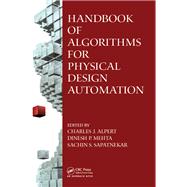Handbook of Algorithms for Physical Design Automation
, by Charles J. Alpert- ISBN: 9781420013481 | 1420013483
- Cover: Nonspecific Binding
- Copyright: 11/12/2008
The physical design flow of any project depends upon the size of the design, the technology, the number of designers, the clock frequency, and the time to do the design. As technology advances and design-styles change, physical design flows are constantly reinvented as traditional phases are removed and new ones are added to accommodate changes in technology. Handbook of Algorithms for Physical Design Automationprovides a detailed overview of VLSI physical design automation, emphasizing state-of-the-art techniques, trends and improvements that have emerged during the previous decade. After a brief introduction to the modern physical design problem, basic algorithmic techniques, and partitioning, the book discusses significant advances in floorplanning representations and describes recent formulations of the floorplanning problem. The text also addresses issues of placement, net layout and optimization, routing multiple signal nets, manufacturability, physical synthesis, special nets, and designing for specialized technologies. It includes a personal perspective from Ralph Otten as he looks back on the major technical milestones in the history of physical design automation. Although several books on this topic are currently available, most are either too broad or out of date. Alternatively, proceedings and journal articles are valuable resources for researchers in this area, but the material is widely dispersed in the literature. This handbook pulls together a broad variety of perspectives on the most challenging problems in the field, and focuses on emerging problems and research results.






